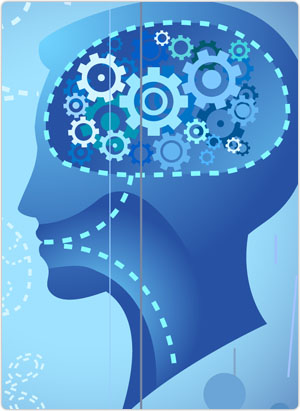Visual
 You mean I have a visual disability? Whenever I ask a large group of people whether or not they have a visual disability, very few of them answer that they do. Then I ask whether or not anyone uses any assistive technology to overcome their visual disability. Most people are unsure what I mean. Invariably, though, as I look out across the group, I see many of them, often a majority, using an assistive technology for their vision at that very moment.
You mean I have a visual disability? Whenever I ask a large group of people whether or not they have a visual disability, very few of them answer that they do. Then I ask whether or not anyone uses any assistive technology to overcome their visual disability. Most people are unsure what I mean. Invariably, though, as I look out across the group, I see many of them, often a majority, using an assistive technology for their vision at that very moment.
"How many of you have perfect vision?" I ask. At this point, at least a couple of people catch on to what I am about to say. A voice in the audience says, "I wear glasses," "Yes," I say. "You wear glasses, and glasses are...?" "An assistive technology!" says someone in the audience, and that is exactly what they are.
EyeglassesWe are all so accustomed to seeing people wear glasses or contact lenses that we do not think of poor vision as a disability. Scientists and inventors have developed corrective lenses to compensate for the deformities in the shape of our eyes, affording us the possibility of seeing with perfect, though somewhat artificial, vision. Many of us have natural vision so flawed that there is no question we would have a disability were it not for our glasses. Bad eyesight is so common, and it is so easy to correct with glasses, that we often forget how different our lives would be without this incredible technological device.
Others of us have visual disabilities that are not so easily corrected, nor so easily forgotten. Some of us have no vision at all. Total lack of vision represents the extreme end of the scale of a condition that we call blindness. As it turns out, most people who are considered "legally blind" do have some vision. Legal blindness is commonly defined as a condition in which the best corrected visual acuity is 20/200, or less, or the person's visual field is 20 degrees or less. Despite the lack of visual acuity, people who are blind have an amazing array of assistive technologies available to them which help compensate for their lack of vision. We'll take a closer look at some of these technologies. magnifying glass.
Another category of visual disability, low vision, is a common condition among the elderly, but younger individuals may also have this disability, whether due to genetics, traumatic injuries, or illnesses. The last big category of visual disability is color-blindness, though it is probably an overstatement to call color-blindness a disability, since the conditions under which color-blindness is a true limitation are few. Still it is helpful to be aware of color-blindness when designing web content, as we will soon "see."
Auditory
 Most developers don't think about individuals who are deaf when they think of web accessibility. For too many developers, web accessibility consists of adhering to a few guidelines that ensure accessibility to screen readers for the blind. On one level, this is understandable. People who are blind will have the most trouble, since the web is a visual medium... or is it?
Most developers don't think about individuals who are deaf when they think of web accessibility. For too many developers, web accessibility consists of adhering to a few guidelines that ensure accessibility to screen readers for the blind. On one level, this is understandable. People who are blind will have the most trouble, since the web is a visual medium... or is it?
On a basic level, the web is information. That information can be presented visually or auditorily. It can be presented in graphics, video, audio, animation, or in text. Our most common experience with web content is what we view through the portal of our web browser, which generally consists of text and graphics, but the web is much more than this. Anyone who has ever used RealPlayer, Windows Media Player, or Quicktime knows that these programs can play video content from the web. In fact, in many cases it is unnecessary to open a browser at all. These media players are themselves browsers. They can access web-based multimedia content, and some can even display HTML content.
Motor
Many of you likely remember Christopher Reeve, famous as an actor, and later famous for his condition of quadriplegia and his unrelenting activism on behalf of spinal cord injury research. Mr. Reeve was thrown from his horse in 1995 during a competitive equestrian event, leaving him completely paralyzed from the neck down due to a spinal cord injury. During the almost 10 years after his injury—before he passed away in 2004—he regained some sensation and mobility, but not enough to be able to use a computer without some kind of assistive technology.
When asked in an online, chat-based interview if he saw "this medium of cyberspace as one that's particularly useful for people society labels as 'disabled?'" Mr. Reeve replied:

"Yes. [The Internet is] an essential tool. And, literally, a lifeline for many disabled people. I have Dragon Dictate. And while I was in rehab, I learned to operate it by voice. And I have enjoyed corresponding with friends and strangers with that system. Many disabled people have to spend long hours alone. Voice-activated computers are a means of communication that can prevent a sense of isolation."
Have you ever thought of the Internet as being "essential" or "a lifeline for many disabled people?" Think about it for a minute. There are certain things that people with disabilities simply cannot do for themselves. But, if they can use a computer connected to the world via the Internet, they have a high degree of independence. They can read the news, research areas of interest, purchase supplies, and access the world—at least potentially. They are independent as long as the sites that they want to access are designed to permit disability access.
Mr. Reeve was fortunate to have a voice that is understandable enough to be processed by voice recognition software. Not everyone with a motor disability can take advantage of this particular technology, but there are many other technologies that can help such people. We'll talk about these technologies, as well as some of the types of motor disabilities. (Read more about Christopher Reeve and his support of spinal cord research at The Christopher Reeve Paralysis Foundation - http://www.christopherreeve.org)
Cognitive
 The concept of cognitive disabilities is extremely broad, and not always well-defined. In loose terms, a person with a cognitive disability has greater difficulty with one or more types of mental tasks than the average person. There are too many types of cognitive disabilities to list here, but we will cover some of the major categories. Most cognitive disabilities have some sort of basis in the biology or physiology of the individual. The connection between a person's biology and mental processes is most obvious in the case of traumatic brain injury and genetic disorders, but even the more subtle cognitive disabilities often have a basis in the structure or chemistry of the brain.
The concept of cognitive disabilities is extremely broad, and not always well-defined. In loose terms, a person with a cognitive disability has greater difficulty with one or more types of mental tasks than the average person. There are too many types of cognitive disabilities to list here, but we will cover some of the major categories. Most cognitive disabilities have some sort of basis in the biology or physiology of the individual. The connection between a person's biology and mental processes is most obvious in the case of traumatic brain injury and genetic disorders, but even the more subtle cognitive disabilities often have a basis in the structure or chemistry of the brain.
A person with profound cognitive disabilities will need assistance with nearly every aspect of daily living. Someone with a minor learning disability may be able to function adequately despite the disability, perhaps even to the extent that the disability is never discovered or diagnosed. Admittedly, the wide variance among the mental capabilities of those with cognitive disabilities complicates matters somewhat. In fact, one may reasonably argue that a great deal of web content cannot be made accessible to individuals with profound cognitive disabilities, no matter how hard the developer tries. Some content will always be too complex for certain audiences. This is unavoidable. Nevertheless, there are still some things that designers can do to increase the accessibility of web content to people with less severe cognitive disabilities.
Seizure
Some people are susceptible to seizures caused by strobing, flickering, or flashing effects. This kind of seizure is sometimes referred to as a photoepileptic seizure because it is caused by pulses of light (hence the prefix "photo") interacting with the eye's light-receptive neurons and the body's central nervous system. 
Most web content is completely harmless to individuals with photoepileptic tendencies. Even most animations, videos, moving text, and Flash objects do not present any danger. However, some developers insist on dramatic effects of flashing or flickering lights and strobe-like effects. Science-fiction style Flash objects, horror movie previews, and cheap-looking banner ads are among the worst offenders. Maybe the creators of these effects think they're "cool," but they are also potentially dangerous. Developers should make every effort to ensure that their content does not have strobing, flickering, or flashing effects.